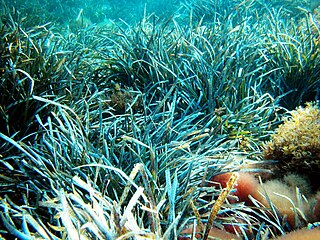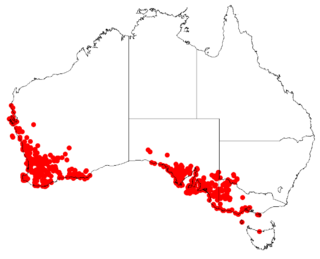
Lavandula is a genus of 47 known species of flowering plants in the mint family, Lamiaceae. It is native to the Old World and is found in Cape Verde and the Canary Islands, and from Europe across to northern and eastern Africa, the Mediterranean, southwest Asia to southeast India.

Conjola National Park covers 11,060 hectares and lies on the mid south coast of New South Wales, Australia, between Sussex Inlet and Lake Conjola, 165 km southwest of Sydney.
Ironwood is a common name for many woods or plants that have a reputation for hardness, or specifically a wood density that is heavier than water, although usage of the name ironwood in English may or may not indicate a tree that yields such heavy wood.

Elaeagnus angustifolia, commonly called Russian olive, silver berry, oleaster, or wild olive, is a species of Elaeagnus, native to western and central Asia, Iran, from southern Russia and Kazakhstan to Turkey, parts of Pakistan and parts of India. As of 2020, it is widely established in North America as an introduced species.

Backhousia citriodora is a flowering plant in the family Myrtaceae, genus Backhousia. It is endemic to subtropical rainforests of central and south-eastern Queensland, Australia, with a natural distribution from Mackay to Brisbane. Other common names are sweet verbena tree, sweet verbena myrtle,, and lemon scented backhousia.

Backhousia is a genus of thirteen currently known species of flowering plants in the family Myrtaceae. All the currently known species are endemic to Australia in the rainforests and seasonally dry forests of Queensland, New South Wales and Western Australia.

Lavandula angustifolia, formerly L. officinalis, is a flowering plant in the family Lamiaceae, native to the Mediterranean. Its common names include lavender, true lavender or English lavender ; also garden lavender, common lavender, and narrow-leaved lavender.

Backhousia myrtifolia is a small rainforest tree species which grows in subtropical rainforests of Eastern Australia. First discovered and subsequently used by the indigenous communities of Australia, this plant produces oils that have a cinnamon-like aroma, and display both anti-bacterial and anti-fungal properties. Therefore, it has potential applications as not only a spice in food preparation, but also in the medical field as a treatment option for microbial infection. Backhousia myrtifolia can grow up to 30 metres. The leaves are ovate or elliptic, 4–7 cm long, and the flowers star-shaped in appearance.

Fraxinus angustifolia, the narrow-leaved ash, is a species of Fraxinus native to central and southern Europe, northwest Africa, and southwest Asia.

Hakea salicifolia commonly known as the willow-leaved hakea, is species of flowering plant that is endemic to eastern Australia. It is an adaptable, fast growing small tree or shrub with attractive foliage and cream white flowers.
Grevillea curviloba is a prostrate to erect shrub that is endemic to Perth, Western Australia.

Posidonia is a genus of flowering plants. It contains nine species of marine plants ("seagrass"), found in the seas of the Mediterranean and around the south coast of Australia.

Podotheca angustifolia, commonly known as Sticky Longheads, is a species of herb native to Australia.

Backhousia leptopetala is a common Australian tree, growing from Stanwell Park in the northern Illawarra district to near Buderim in south eastern Queensland.

Lomatia myricoides, commonly known as the river lomatia, is a shrub native to New South Wales and Victoria in southeastern Australia.

Backhousia tetraptera is a tree in the family Myrtaceae. The only known population occurs at the foot of Mount Stuart near Townsville in Queensland, Australia.
Echiomima mythica is a moth in the family Xyloryctidae. It was described by Edward Meyrick in 1890. It is found in Australia, where it has been recorded from New South Wales and Queensland.

Hakea lasianthoides is a shrub or tree in the family Proteaceae and is endemic to Western Australia. It has creamy-white flowers, mostly linear leaves and flowers from September to November.

Philotheca angustifolia, commonly known as narrow-leaf wax flower, is a species of flowering plant in the family Rutaceae and is endemic to south-eastern Australia. It is a shrub with small leaves and white flowers with five egg-shaped petals in spring.














